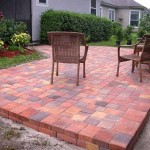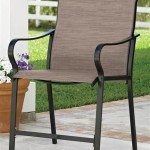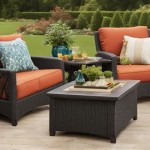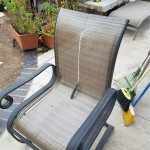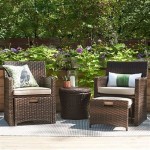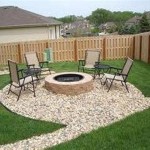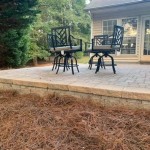Round Patio Table Top Replacement Ideas
A round patio table serves as a focal point for outdoor gatherings, offering a space for dining, conversation, and relaxation. However, the table top, being exposed to the elements, is often the first component to show signs of wear and tear. Weathering, scratches, and impacts can diminish its aesthetic appeal and even compromise its structural integrity. When the damage becomes too extensive to repair, replacing the table top becomes a practical solution. Fortunately, there are numerous round patio table top replacement ideas to revitalize the table and enhance the outdoor living space.
The selection of a suitable replacement table top involves considering several factors, including the table's frame size, the desired material, the overall style, and the budget. Careful assessment of these aspects ensures the chosen replacement not only fits the existing frame but also complements the outdoor décor and provides lasting durability. This article will explore various material options and design considerations to guide the selection process and provide a comprehensive overview of round patio table top replacement ideas.
Material Options for Round Patio Table Tops
The longevity and aesthetic appeal of a patio table top are heavily influenced by the material used. Each material offers unique benefits and drawbacks, making it important to understand their characteristics before making a decision. Popular choices include wood, glass, metal, stone, and composite materials, each offering a distinct look and performance profile.
Wood: Wood is a classic choice for patio furniture, known for its warm and inviting aesthetic. Popular wood options for patio table tops include teak, cedar, and redwood, all of which are naturally resistant to decay and insect infestation. Teak, in particular, is highly regarded for its exceptional durability and resistance to moisture, making it an excellent choice for outdoor use. However, wood requires regular maintenance, such as cleaning and sealing, to prevent warping, cracking, and fading. Pressure-treated lumber can be a more affordable option but may not offer the same aesthetic appeal or longevity as hardwoods. The natural variations in grain and color make each wood table top unique, adding character to the outdoor space.
Glass: Glass table tops offer a sleek and modern look, providing a smooth and easy-to-clean surface. Tempered glass is the preferred choice for patio tables because it is significantly stronger and more resistant to breakage than standard glass. If tempered glass does break, it shatters into small, relatively harmless pieces, minimizing the risk of injury. Glass table tops can be clear, frosted, or tinted, allowing for customization to match the desired aesthetic. While glass is resistant to staining and fading, it can be susceptible to scratches and chips. The transparency of glass can also showcase the table's base, adding a visual element to the overall design. Glass is also vulnerable to extreme temperature changes, which can cause cracking in some instances.
Metal: Metal table tops, such as aluminum and steel, offer durability and a clean, contemporary look. Aluminum is lightweight and rust-resistant, making it a suitable choice for outdoor environments. Powder-coated aluminum provides additional protection against scratches and corrosion. Steel is stronger than aluminum but is susceptible to rust if not properly treated. Galvanized steel, which is coated with zinc, offers enhanced rust resistance. Metal table tops can be designed with various patterns and finishes, adding visual interest to the patio. However, metal can become hot in direct sunlight, which can be uncomfortable for users. Cushions and umbrellas can help mitigate this issue. Metal also tends to be louder when items are placed on it, so placement is important if noise is a concern.
Stone: Stone table tops, such as granite, marble, and slate, provide a luxurious and durable option for outdoor furniture. Granite is highly resistant to scratches, stains, and heat, making it an excellent choice for a patio table top. Marble offers a classic and elegant look but is more porous than granite and requires sealing to prevent staining. Slate provides a rustic and natural appearance and is resistant to water damage. Stone table tops are heavy and require a sturdy base to support their weight. They also tend to be more expensive than other options. The natural variations in color and pattern make each stone table top unique, adding a touch of sophistication to the outdoor space.
Composite Materials: Composite materials, such as resin and recycled plastic, offer a low-maintenance and environmentally friendly option for patio table tops. These materials are resistant to fading, cracking, and warping and require minimal upkeep. Composite table tops can be designed to mimic the look of wood or stone, providing a versatile and cost-effective alternative. They are also lightweight and easy to handle, making them a practical choice for outdoor furniture. The durability and weather resistance of composite materials make them a popular choice for homeowners seeking a long-lasting and low-maintenance patio table top.
Design Considerations for Round Patio Table Tops
Beyond the material selection, several design considerations contribute to the overall aesthetic and functionality of a round patio table top. These include the edge profile, the surface finish, and the inclusion of features such as umbrella holes. Carefully considering these design elements ensures that the replacement table top complements the outdoor décor and meets the specific needs of the user.
Edge Profile: The edge profile of a table top can significantly impact its appearance and feel. Common edge profiles include rounded, beveled, and straight edges. Rounded edges provide a soft and comfortable feel, while beveled edges offer a more refined and elegant look. Straight edges offer a clean and contemporary aesthetic. The choice of edge profile depends on the desired style and the overall design of the patio furniture. A rounded edge is often preferred for tables used by families with young children, minimizing the risk of injury from sharp corners. The edge profile can also influence the perceived thickness of the table top, with thicker edges appearing more substantial and durable.
Surface Finish: The surface finish of a table top can affect its appearance, texture, and maintenance requirements. Common surface finishes include smooth, textured, and distressed finishes. Smooth finishes are easy to clean and maintain, while textured finishes provide a more tactile and slip-resistant surface. Distressed finishes offer a rustic and weathered look, adding character to the patio furniture. The choice of surface finish depends on the desired aesthetic and the intended use of the table. A smooth finish is often preferred for dining tables, while a textured finish is suitable for tables used for serving food and drinks. For wood surfaces, stain and sealer can greatly affect the final appearance and can protect the wood from the elements.
Umbrella Hole: An umbrella hole is a practical feature for patio tables, providing shade and protection from the sun. When selecting a replacement table top, consider whether an umbrella hole is needed and its size and placement. The umbrella hole should be large enough to accommodate the umbrella pole and should be positioned in the center of the table for optimal balance and stability. Some table tops feature a removable plug that covers the umbrella hole when not in use, providing a seamless and clean look. It's also important to ensure that the table base is compatible with the umbrella pole diameter and that the table is stable enough to support the weight of the umbrella, especially in windy conditions. The placement of the umbrella hole should also be considered in relation to the seating arrangement to ensure that all guests are adequately shaded.
Installation and Maintenance of Round Patio Table Tops
Proper installation and maintenance are crucial for ensuring the longevity and performance of a round patio table top. The installation process involves securely attaching the table top to the existing frame, while maintenance includes regular cleaning and protection from the elements. Following these steps ensures that the replacement table top remains in good condition for years to come.
Installation: Before installing the replacement table top, ensure that the existing frame is clean and stable. Inspect the frame for any signs of damage or rust and repair as needed. Measure the dimensions of the frame to ensure that the replacement table top fits properly. Use appropriate hardware, such as screws or bolts, to securely attach the table top to the frame. If necessary, pre-drill pilot holes to prevent splitting the wood or damaging the frame. Tighten all hardware securely, but avoid over-tightening, which can damage the table top or frame. For stone table tops, use a suitable adhesive to bond the table top to the frame, ensuring a strong and stable connection. If the table top is particularly heavy, consider enlisting assistance to lift and position it properly.
Cleaning: Regular cleaning is essential for maintaining the appearance and hygiene of a patio table top. The cleaning method depends on the material of the table top. For wood table tops, use a mild soap and water solution and scrub with a soft brush or cloth. Rinse thoroughly with clean water and allow to dry completely. Avoid using harsh chemicals or abrasive cleaners, which can damage the finish. For glass table tops, use a glass cleaner and a soft cloth to remove dirt and smudges. For metal table tops, use a mild soap and water solution and scrub with a soft brush or cloth. Rinse thoroughly with clean water and dry immediately to prevent rust. For stone table tops, use a stone cleaner specifically designed for the material. Avoid using acidic cleaners, which can etch the surface of the stone. For composite table tops, use a mild soap and water solution and scrub with a soft brush or cloth. Rinse thoroughly with clean water and allow to dry completely.
Protection from the Elements: Protecting the patio table top from the elements is crucial for preventing damage and extending its lifespan. When not in use, cover the table with a waterproof patio furniture cover to protect it from rain, snow, and sun. Store the table indoors during the winter months to prevent damage from freezing temperatures. Apply a sealant or protective coating to the table top to protect it from moisture and UV rays. For wood table tops, apply a wood sealant or stain every year or two to maintain its appearance and protect it from the elements. For stone table tops, apply a stone sealant every year or two to prevent staining and water damage. Regularly inspect the table top for any signs of damage, such as cracks, chips, or scratches, and repair as needed. Address any issues promptly to prevent further damage and extend the life of the table top.

Diy Replace Glass Tabletop With Tile Weekend Warrior Wednesday Your Modern Family Table Top Patio Round

Glass Table Base Ideas Unique Bases For Patio Tops

Diy Patio Table Top Fixing A Broken On Budget

These Diy Instructions Might Work To Fix The Top Of My Rectangular Glass Patio Table Which Shattered And Nee Wood Round

Diy Patio Table Top Fixing A Broken On Budget

Tempered Patio Glass Table Tops Replacement For

Diy Replace Glass Tabletop With Tile Weekend Warrior Wednesday Your Modern Family Outdoor Table Tops Patio Top Redo

Diy Replace Glass Tabletop With Tile Weekend Warrior Wednesday Your Modern Family

How To Patio Table Makeover

Glass Tables Outdoor Tropitone Furniture
See Also


